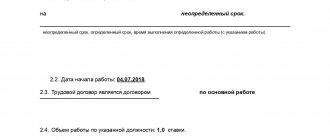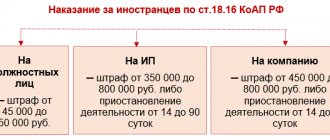No labor organization, unfortunately, can completely eliminate the likelihood of accidents at work. These are unfortunate moments, sad both for the victim himself and for his employer. They can be very diverse. Meanwhile, in order to investigate and further prevent such situations, as well as to pay compensation to the victim and build further labor relations with him, it is important to find out which category the incident falls into. In this article we will look at what groups industrial accidents can be divided into from the point of view of official regulations.
What is an industrial accident
The concept of an industrial accident in the Labor Code of the Russian Federation is specified in Article 227; it is harm to the health of an employee or other persons who participate in production activities (for example, students undergoing an internship) while performing work duties, on the way to or from work, if transportation carried out by the employer) or during a business trip.
The comments to Article 227 of the Labor Code of the Russian Federation list which accidents are classified as industrial:
- injuries to the body that are caused either by other persons or by machinery;
- burns;
- frostbite;
- wounds or bites caused by insects or animals;
- electric shock and radiation;
- acute poisoning;
- damage caused by a building collapse, explosion or natural disaster;
- other injuries received as a result of external factors, due to which the employee lost his ability to work (both temporarily and permanently) or died.
Work-related injuries are not:
- damage received at the workplace during working hours if the employee commits a crime;
- injuries sustained if the employee was under the influence of alcohol or drugs;
- if the damage was received on the territory of the enterprise, but not during working hours.
Causes of accidents
The main causes of accidents at work are:
- technical shortcomings and unreliability of equipment;
- use of faulty mechanisms, equipment and machinery;
- violation of safety requirements during equipment operation;
- disruption of the technological process;
- poorly organized production work;
- improper maintenance of workplaces;
- lack of training and testing of knowledge on labor protection, as well as failure to provide instructions;
- the employee lacks personal protective equipment, including if the employer did not provide them;
- violation of labor discipline by an employee (being at the workplace under the influence of alcohol and drugs);
- the employee performed a task outside his specialty by order of management.
All reasons are divided into:
- technical, i.e. injuries were sustained due to imperfect technology;
- organizational, i.e. the incident occurred due to an improperly organized labor process;
- personal or psychophysical, when the incident arose as a result of the actions of a certain person.
As a rule, an industrial accident occurs not for one reason, but for a combination of several.
Basic Concepts
Trauma is damage to body tissues and disruption of its functions in accidents, i.e. when workers are exposed to hazardous production factors. They can be mechanical (bruise, cut, fracture, dislocation, etc.), thermal (burn, frostbite), chemical (chemical burn), electrical (burn, metallization of the skin, electroophthalmia of the eyes, etc.), psychological (nervous stress, fear and etc.).
It would not be amiss to mention such a concept as microtrauma.
Microtrauma is an injury that does not result in a temporary loss of the worker’s ability to work and the need for his transfer to another job.
These include minor tissue damage to the employee: an injection, a small cut, a scratch, abrasions
We must understand that the same microtrauma can have different meanings for an employee depending on his field of work. For example, for most, a cut on a finger will not be an obstacle to continuing to work, but for an electrician, it may become an obstacle to continuing his professional activity.
Today, the law does not oblige to investigate and take into account microtraumas; the manager himself decides to do this or not. In large organizations, the practice of recording, systematizing and analyzing microtraumas is increasingly spreading, this allows timely measures to be taken to improve the work process and prevent accidents.
By the way, the State Duma is discussing a bill that will oblige managers to investigate and take into account all micro-injuries committed at the enterprise.
An industrial accident is an event as a result of which the insured received an injury (mutilation) or other damage to health during the performance of his duties under an employment contract and in other cases established by this Federal Law, both on the territory of the insurer and outside it, or while traveling to place of work or return from work using transport provided by the insured, and which entailed the need to transfer the insured to another job, temporary or permanent loss of professional ability to work, or his death.
(as amended by Federal Law dated December 8, 2010 No. 348-FZ)
Injuries can lead to temporary or permanent disability, and the victim may lose general ability to work or only professional ability.
Loss of professional ability to work means that the victim cannot work in his profession, but can be employed in other jobs. Loss of general ability to work means that the victim partially or completely loses the ability to perform any work.
An accident (injury or illness) can be caused by one, but more often than not, several related or unrelated reasons that create a dangerous situation in the workplace. A hazardous situation includes hazardous conditions and hazardous activities.
Hazardous conditions are a state of the production environment that does not comply with established standards, which is expressed in the presence of certain dangerous and harmful production factors in the workplace and is a consequence of many reasons.
Dangerous actions are an incorrect, unprofessional action of an employee, which is a consequence of lack of training, inability, unwillingness, inability, and in some cases, the inability of the worker to correctly assess the production situation and comply with all the requirements of labor protection standards and rules. Dangerous actions are usually subjective, i.e. depend on the individual worker.
The likelihood of an accident depends on working conditions, and it is higher under Dangerous and Harmful working conditions . But in practice, this is usually not the case, since usually in enterprises with such working conditions, the labor protection service is better organized, employees of the organization receive better labor protection training, and briefings are conducted more often.
Hazardous working conditions are working conditions in which the employee is exposed to harmful and (or) hazardous production factors, the levels of exposure to which during the entire working day (shift) or part of it can create a threat to the life of the employee, and the consequences of exposure to these factors cause a high risk development of acute occupational disease during work.
Harmful working conditions are working conditions under which the employee is exposed to harmful and (or) dangerous production factors, the levels of exposure of which can lead to the emergence and development of severe forms of occupational diseases (with loss of general ability to work) during the period of work.
Occupational disease is a disease caused by exposure to harmful working conditions (GOST 12.0.002). Harmful production factors can cause temporary, long-term or permanent loss of ability to work (disability).
A special case of occupational disease is occupational poisoning (acute or chronic).
Return to content
Classification of industrial accidents
There are two classifications of industrial accidents: by the number of victims and by the severity of the consequences. Based on the number of victims, there are the following types of industrial accidents:
- individual, when only 1 person is injured;
- a group accident when 2 or more people were injured at the same time.
According to severity, accidents are divided into:
- microtraumas: when the employee does not lose his ability to work, and his health is restored within one or several days;
- lungs: due to injuries, the employee temporarily loses ability to work and fully recovers within 1 month;
- severe: if it takes more than 1 month to restore working capacity, some consequences after the injury are irreversible and the employee receives a degree of disability;
- fatal: when a fatal accident occurs at work.
The severity of NS is determined by Order of the Ministry of Health and Social Development No. 160.
Please note that severe consequences of an incident also include:
- injuries that were caused by shock, bleeding or damage to vital organs, even if the employee recovered in less than 1 month;
- injuries, the consequences of which were not immediately apparent and were discovered in the ambulance, emergency room, intensive care unit, etc.;
- damage with irreversible consequences that are not life-threatening (deafness, blindness, etc.).
Classification according to the reasons that caused the injuries
Factors that cause injuries are mechanical, thermal, electrical and chemical.
Mechanical injuries are the most common injuries encountered in the factory. These may include abrasions with bruising, dislocations and fractures. Can be caused by careless handling of rotating and sharp mechanisms or equipment parts.
Thermal burns include cold injury. Acquired from exposure to high temperatures, chemicals and radiation energy.
Electrical injuries include injuries caused by electric current. Passing through the body and tissues, the current produces thermal burns, causes shock and destroys the functioning of vital organs. Leads to consequences of the second and third severity.
Chemical burns include first, second and third severity burns.
Note! As a rule, burns are caused by alkali with concentrated acids, phenols, metal salts, bitumen, lime, phosphorus, gasoline and kerosene.
Classification of injuries
Actions of the employee and employer
In accordance with Article 214 of the Labor Code of the Russian Federation, the employee’s duty in the event of an accident is to notify the employer about the incident. However, the form of the message is not established by law. It may be specified in the organization's charter or safety instructions.
The sequence of actions of the manager is indicated in Article 228 of the Labor Code of the Russian Federation. It lists the priority measures that the employer must take.
The manager's procedure is as follows:
- Provide first aid. If necessary, transport the victim to the hospital.
- In the event of an accident at work, the employer’s responsibilities include taking all possible measures to stop the emergency. He must call special services to eliminate the consequences and protect the rest of the employees.
- If possible, keep the situation as it was at the time of the incident. If this is not possible, capture it in a photo or video.
- In the event of serious consequences or death of the victim, the employer must notify the employee’s relatives.
- Within 24 hours, send a notice of the accident to the local executive authority, which is responsible for overseeing compliance with labor laws; to the prosecutor's office at the scene of the incident; to local government authorities at the place of registration of the enterprise; to the territorial body that is responsible for control in the area in which the organization operates; to the local FSS authority; to the trade union.
Responsibilities of the employer in the event of an accident
According to the Labor Code, the employer or his representative is obliged to:
- immediately organize first aid for the victim and, if necessary, transport him to a medical organization;
- take urgent measures to prevent the development of an emergency or other emergency situation and the impact of traumatic factors on other persons;
- until the investigation of the accident begins, preserve the situation as it was at the time of the incident, if this does not threaten the life and health of other persons and does not lead to a catastrophe, accident or other emergency circumstances, and if it is impossible to preserve it, record the current situation (draw up diagrams , take photographs or videos, and other events);
- immediately inform the authorities and organizations specified in this Code, other federal laws and other regulatory legal acts of the Russian Federation about the accident, and about a serious accident or fatal accident - also the relatives of the victim;
- take other necessary measures to organize and ensure a proper and timely investigation of the accident and registration of investigation materials in accordance with this chapter.
Any adequate employer is no less interested than the victim in ensuring that the accident investigation is carried out efficiently and in a timely manner, and in order to prevent such cases in the future, it is very important, based on the facts identified during the investigation:
- Identify and eliminate previously unaccounted for hazards that led to injury. For this purpose, new technical solutions are being applied, measures are being introduced to improve the quality of worker training in occupational safety, and unscheduled inspections of the condition of equipment and working conditions are organized.
Properly eliminating existing hazards will help prevent similar accidents.
- Determine whether the injury is related to the production process.
The Labor Code of the Russian Federation clearly defines situations in which NS is considered to be related to production.
An unscrupulous employee may try to pass off a domestic injury as an industrial injury, so it is very important for the employer to establish the true circumstances and causes of the incident.
- Understand why the work injury occurred: due to the fault of the employee, other persons, due to force majeure (for example, a hurricane, flood, earthquake), etc. It is important to know this in order to work correctly with employees who have committed violations: organize additional training, impose penalties, and assess compliance with the positions held.
- Correctly assign benefits and compensation related to work injuries.
The responsibilities of the head of the organization and the algorithm of actions in case of an accident are simplified and can be depicted in the form of a diagram:
Return to content
First aid to the victim
First aid in case of accidents at work is provided by employees and the employer until the ambulance arrives. To do this, the organization must have a first aid kit containing everything necessary.
It is worth noting that, first of all, in the event of an accident at work, it is necessary to make sure that the consequences of the accident do not pose a threat to other employees. If there is a danger, it is necessary to eliminate it, then provide assistance to the employee.
The first thing to do is to remove the source of the accident from the victim and free the respiratory system. Then it is necessary to determine the nature of the damage and do everything possible to maintain basic vital functions until the ambulance arrives.
Documentation of the incident
If an accident occurs at work, the employer must draw up a number of documents. The first thing to do is create a commission. To do this, the manager draws up an order to investigate an industrial accident, which approves the composition of the commission. Only after this does it become clear who is to blame for the accident.
After an investigation, the fact of an industrial accident is documented using Form N-1. It should contain:
- the date of the incident;
- information about the employer;
- data of the victim;
- information about the members of the commission;
- details of the incident;
- causes of the accident;
- information about who is responsible for the incident;
- information about who is responsible for labor protection at the enterprise and about the conduct of labor safety training.
An industrial accident report is drawn up in several copies: for the employer, the victim and the Social Insurance Fund. If the NS is severe or group, the acts are also sent to the labor inspectorate, the prosecutor's office, local authorities, territorial bodies that control the activities of the enterprise, to Rostrud and to the trade union organization.
Also, the accident is registered in a special journal according to Form No. 9.
After the victim’s recovery, the employer must also report the consequences of the accident to Rostrud and the local authority that exercises control in the area of the organization’s activities. Documents are filled out according to Form 8, which is approved by Resolution No. 73.
Materials from the investigation of an industrial accident are stored for 45 years at the enterprise.
Procedure for investigating industrial accidents
After the incident, a record and investigation of the industrial accident is required. For this purpose, a commission is created, which is approved by the management of the enterprise. The algorithm for carrying out the procedure is specified in Article 229.2 of the Labor Code of the Russian Federation.
Next, we will briefly describe the procedure for investigating industrial accidents:
- The commission collects testimony from the victim, eyewitnesses, the employer, as well as from the person responsible for labor protection and draws up a protocol for interviewing witnesses.
- Creates photo and video recording of what happened, draws up a diagram or plan of the accident site.
- Conducts examination or laboratory research as necessary.
- Collects investigation materials (extracts from journals noting the briefings carried out, a medical report on the condition of the victim, documents confirming the issue of special clothing to the employee).
After this, investigation materials are prepared, which indicate the cause of the accident and the culprit.
Please note that all costs of the investigation are borne by the employer.
Who is conducting the investigation?
An industrial accident is investigated by a representative of the enterprise where the accident occurred, a trade union member and a labor protection specialist. The commission to investigate a fatal and serious accident also includes a representative of the Social Insurance Fund, an employee of the labor inspectorate and a city or district administration.
The victim, his relative or representative also have the right to take part in the investigation.
If the injured party does not agree with the results, an additional investigation is carried out by the state labor inspector.
Investigation period
The time frame for investigating an industrial accident is 3 days. In cases where there are multiple victims or a serious or fatal accident is being investigated, the process may take 15 days.
If the employee’s disability manifests itself some time after the accident, the victim must notify the commission about this. In this case, the period for considering an accident increases to 1 month from the date of receipt of the application from the employee.
Measures to prevent NS
To reduce the number of injuries and deaths at work, management applies the following measures:
- selects suitable premises and high-quality certified equipment for work;
- competently selects workers, registers them and trains them on how to work correctly to avoid injury;
- provides workers with special uniforms and means to ensure personal protection;
- Conducts timely assessments to adjust working conditions;
- provides employees with established social benefits for recreation, and deals with their mandatory insurance for work in the workshop;
Measures to eliminate NS
- forces employees to undergo medical examinations in a timely manner;
- explains to employees how they should act at the enterprise and clearly demonstrates the consequences of failure to comply with occupational safety rules;
- controls the occupational safety knowledge acquired by employees and checks the procedure for fulfilling established requirements;
- conducts professional instruction in a timely manner and records the lesson in the documentation;
- prepares safe work rules and sample documents for them.
Note! Thanks to the correct and careful selection of personnel, it is possible to minimize the occurrence of emergency incidents, since accidents happen less often with qualified employees.
In general, an accident in a factory is a situation where a person was injured during work and this fact was recorded by a special medical commission. Accidents are divided into types. There are NS of the first, second and third degrees of severity. To reduce their number, preventive work is carried out at enterprises.
Set of socks, Omsa socks
349 ₽ More details
Set of socks, Omsa socks
349 ₽ More details
Nuts M6
Consequences for employer and employee
The consequences of accidents at work for an employee are monetary compensation for wages and expenses for treatment and rehabilitation. If the victim is found guilty of the accident, he is entitled only to temporary unemployment benefits.
Cases are quite common in judicial practice when an employee files a claim for reimbursement by the employer of the amount spent on treatment and rehabilitation that is not covered by insurance. As a rule, such cases are resolved in favor of the victim.
The manager, in addition to financial liability, may also be subject to administrative and criminal liability. For example, administrative liability is imposed for concealing an accident at work, for failure to comply with labor protection requirements, for obstructing an investigation, etc. In the event of the death of an employee or serious injuries, the employer may face criminal liability under Article 143 of the Criminal Code of the Russian Federation.
Division of accidents by severity
According to Order No. 160 of the Ministry of Health and Social Development, there are mild and severe consequences of accidents. At the same time, severe injuries have a variety of consequences; health can be restored completely or partially.
Therefore, severe injuries are also divided into separate categories:
- First degree . Such injuries cause shock, blood loss, problems with the nervous and cardiovascular systems, and damage to vital organs. The duration of such an injury does not matter; in any case, it has serious consequences for the health of the victim.
- Second degree . Burns over 15% of the body, miscarriage in a woman, joint injuries, damage to the gastrointestinal tract, damage to blood vessels. Injuries of the second degree of severity are not always immediately obvious; often problems are identified only by a doctor after a thorough examination and additional examination.
- Third degree . Loss of hearing, speech, vision, stoppage of normal functioning of internal organs, mental illness resulting from shock, disfigurement. This category should include all injuries that pose a threat to the employee’s normal functioning and his life.
A separate category includes fatal injuries that cause the death of an employee.
Important
Only qualified doctors can determine the severity of the injury. Therefore, it is very important to immediately send the victim to the first aid station, call an ambulance, and transport him to the hospital.
Note that improper treatment and incorrect diagnosis can lead to the fact that even a minor injury can develop into something serious. Therefore, treatment must be treated very scrupulously.
Important
If the employee’s injury is minor and health can be restored quickly, then the investigation is carried out only within the enterprise, by the employer himself. If the accident results in serious injuries, then representatives of local authorities, the labor inspectorate and, if the employee is insured, the insurer are involved in the investigation. If the serious consequences of the accident occurred through the fault of the employer, he will face criminal liability.
We admit that there are cases that are difficult to classify. For example, two workers got into a fight during lunch break. Both received injuries of varying severity. Is this a household or industrial case? Who is to blame? It will be necessary to create a commission that will establish all the details of the incident and render its verdict.
What payments are due?
The victim is entitled to monetary compensation in the event of an accident. He can receive the following payments:
- for temporary disability (carried out on sick leave);
- a one-time or monthly insurance payment from the Social Insurance Fund if the employee was insured against accidents at work;
- funds for treatment and rehabilitation if insurance does not cover all costs.
Please note that in the event of death, the relatives of the victim are also entitled to payments.
In the event of an accident, the employer is obliged to pay 100% of wages, regardless of length of service.
Enterprise injury rate
The rate is expressed by the total number of times a person is injured or dies. It is derived from the total number of cases and the total number of employees.
Thanks to the injury rate at work, it is possible to detect the preconditions for the occurrence of emergency situations, identify patterns of injuries and identify dangerous zones.
The coefficient is calculated using a special formula Ch = K * 1000 / Sk, where Ch is the frequency coefficient, K is the number of incidents, and Sk is the average number of employees in the period under review.






